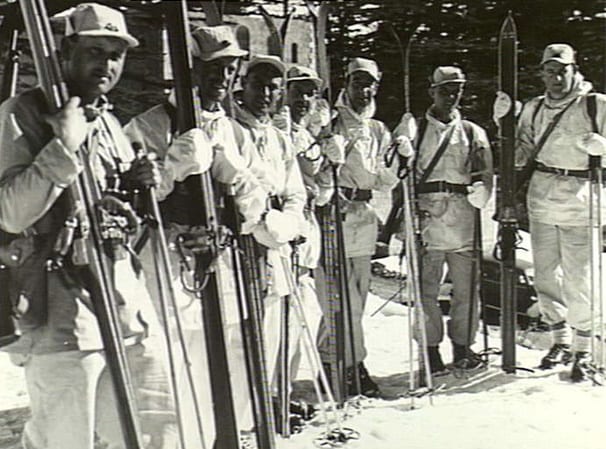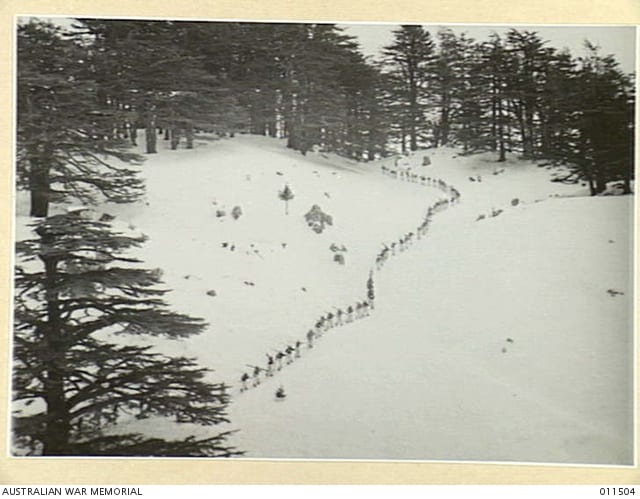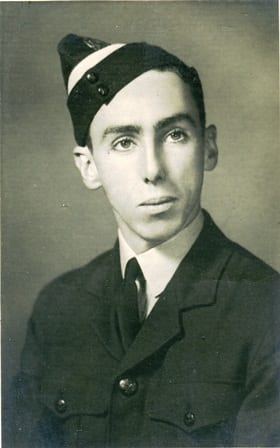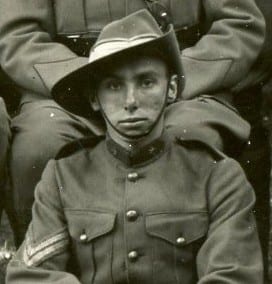
Few realise the Australian armed forces significant involvement with the snow industry and the history of ANZACs contribution to the resorts we love today. So spare a thought this ANZAC Day for the diggers who love/d the snow as much as you do.
The ANZAC community in our ski industry goes as far back as the founders of the country’s commercial ski resorts, if not before. Many of the founders fought in WWII and no doubt even more of our key snow players have served their country in other wars and peacekeeping missions before and since.
Not many remember the once popular resort of Donna Buang in Victoria, but it was home in 1935 to a series of ‘snow manoeuvres’ by the Army Reserve four years before WWII, perhaps a pre-cursor to the Australian Corps Ski School in Lebanon (see below). We do know that 75 years later military members still form a key part of Australia’s snow fields today.
Perisher hosts the Australian Army Alpine Snowsports race week every winter, Hotham is home to the RAAF Games and The Royal Australian Navy Ski Club have lodges in Perisher, Thredbo and Buller for members and ex members of the navy and other armed defense forces.
Of course we wouldn’t deem to imagine we could do justice in 1000 words to all the veterans in our snow history so we encourage you, dear reader, to let us know of those we have not paid tribute to in this post.
We’re not historians, so please forgive any minor errors in our remembrance below, but we are skiers who are thankful for those who served before us.
The Australian ski corps in Lebanon in WWII
The Australian Corps Ski School was formed in 1941 to train Australian troops to operate on skis to fight the Vichy French in the Syrian Campaign. The school was set up in the Taurus Mountains of Lebanon in the famed Cedars where troops were trained in the art of combat on skis. Over 200 soldiers were trained, though their skills were no longer needed once the French were defeated and many were then sent to the Kokoda Trail instead.
- Cedars (Lebanon), Syria. 1941-12. Troops of 1 Corps Ski School in training in the snow. The school was opened on 1941-12-15 to train 160 ski troops for each Australian Division in the Middle East. In the background stands the famous cluster of cedars.
- SYRIA. MAJOR SAVAGE, COMMANDANT OF THE 1 AUSTRALIAN CORPS SKI SCHOOL OPENED IN LEBANON IN DECEMBER 1941. FORMERLY WITH THE SIGNALS CORPS AND FROM CONCORD, HE IS WITH MAJOR RIDDELL, CHIEF INSTRUCTOR OF THE SCHOOL. THEY BOTH WEAR WHITE ALPINE GEAR. (NEGATIVE BY F. HURLEY).
- SYRIA. TRAINEES AT THE 1 AUSTRALIAN CORPS SKI SCHOOL SET OUT ALONG A TRACK ACROSS A SNOW COVERED SLOPE IN THE LEBANON RANGES. THE TREES IN THE BACKGROUND ARE THE FAMOUS CEDARS OF LEBANON. (NEGATIVE BY F. HURLEY). Australian War Museum.
- THE CEDARS, LEBANON. 1941-12. MEMBERS OF THE 1ST AUSTRALIAN CORPS SKI SCHOOL SET OFF FOR A ROUTE MARCH IN THE SNOW. THE MEN ARE WEARING SNOW SHOES.
- An Australian soldier reaches the summit on his snow skis during training at the newly opened 1 Australian Corps Ski School. He wears the white alpine gear common to such units.
- SYRIA. TRAINEES AT THE 1 AUSTRALIAN CORPS SKI SCHOOL OPENED IN LEBANON IN DECEMBER 1941 WEARING THE WHITE ALPINE GEAR COMMON TO SKI TROOPS. (NEGATIVE BY F. HURLEY).
The P.O.W Changi AIF Ski Club
One of the toughest ANZACs within Australia’s ski world was surely Tom Mitchell (1906 – 1984). Captured by the Japanese army, he and his fellow soldiers from the Australian Imperial Force were made prisoners of war at Changi concentration camp in Singapore. The same camp where prisoners were forced to build the Thai Burma railway.
Mitchell was a founder of the Australian Ski Federation in 1932 and he captained the Aussie ski team at the World Champs in ’31, ’33 and ’34. Together with fellow Aussie prisoners with a passion for skiing, they created the Changi A.I.F Ski Club.
Winter Olympics
Mt Buller
Mt Buller’s Fannys Finish run is said to be named after Nathaniel ‘Fanny’ Straus ( who fought in WWII as a Squadron Leader with the RAAF but was shot down in 1945 and died. He was a member of the University Ski Club at Mt Buller in the 1930s and nicknamed Thanny for Nathaniel – the name changed to Fanny after he slid across a race line on his ‘fanny’.
Also at Mt Buller, The Ski Club of Victoria aka ‘The Whitt’ was founded by Major Ivor Whittaker, a keen Buller skier and founding member and president of the Melbourne University Ski Club. He enlisted in the Second Australian Imperial Force in 1939 and was an intelligence officer with the 17th Infantry Brigade (part of the 6th Division) and served in the Middle East, promoted to major and seconded to the 1st Australian Corps Intelligence Section.
He died in active service in World War II during a reconnaissance mission over the Mediterranean in 1941. His will bequeathed £500 for a lodge to be built by the Ski Club of Victoria where it still stands today.
Thredbo
Charles Anton (1916 – 1966) of Thredbo founding fame arrived in Sydney from Austria in 1938, enlisted in the Australian Military Forces in 1942. In 1944 he became an Australian citizen and was transferred to the Australian Imperial Forces the following year.
In September of 45 he competed in the Allied Services Ski-Meeting at Charlotte Pass. Anton went on, after the war, to found the Ski Tourer’s Association in 1950 and then create the syndicate that founded Kosciusko Thredbo.
Fellow Thredbo founder, Andrew Thyne Reid (1901 – 1964) from Randwick in Sydney, enlisted in the Australian Imperial Force in 1939 and became a lieutenant in the Ordnance Corps, then major in 1941 in the Middle East with two months at Tobruk in Libya. In 1942 he returned to Australia a lieutenant colonel in the Directorate of Mechanical Maintenance in Melbourne.
In the 1950s, piloting his own de Havilland Dragon airplane and Drover, Reid would fly the Thredbo syndicate to Cooma wearing his ‘old diggers hat.’
Perisher Smiggins
Norwegian born Sverre Andreas Kaaten (1908 – 1991) was a founder of Perisher Smiggins who arrived in Australia in 1928 in search of Australia’s snowfields. By 1934 he had set a new Australian jump record (43 metres) and skied from Kiandra to Koscuiuszko.
In 1942 he enlisted in the Australian Imperial Force and in 1944 transferred from the Armoured Car Regiment to the Royal Australian Air Force. He spent his service in Australia and went on after the war to become a competitive skier with the New South Wales ski team and built Telemark ski lodge in Perisher in 1952. The rest is, as they say, Perisher history.
The poem that says it all
This poem was written by an Australian soldier training with the Australian Corps Ski School in Lebanon in early 1942.
Over the long white hills they go,
Whish of the ski and spray of snow;
Death cannot halt for anything,
Death cannot wait for early spring.
Death in the snow is soft and sweet,
A blanket warm, a pristine sheet,
A drowsy morphine, heavy shroud,
The fleeting tombstone of a cloud.
Theirs is a world of lonely things,
A frightened fox, a whirr of wings,
A stifled echo through the trees,
The eerie whisperings of the breeze.
Onward they glide, in search of life,
Rucksack and rifle, compass and knife,
Theirs is no mountain health resort;
True, this is snow – but death the sport.
Lebanon, January 1942
NX 52009
Source: “Soldiering On – The Australian Army at home and overseas”
‘prepared by some of the boys’ – Australian War Memorial Press, 1942.
Page 71.
Lest we forget.
*All images are credited and all names have a source link for more information.













